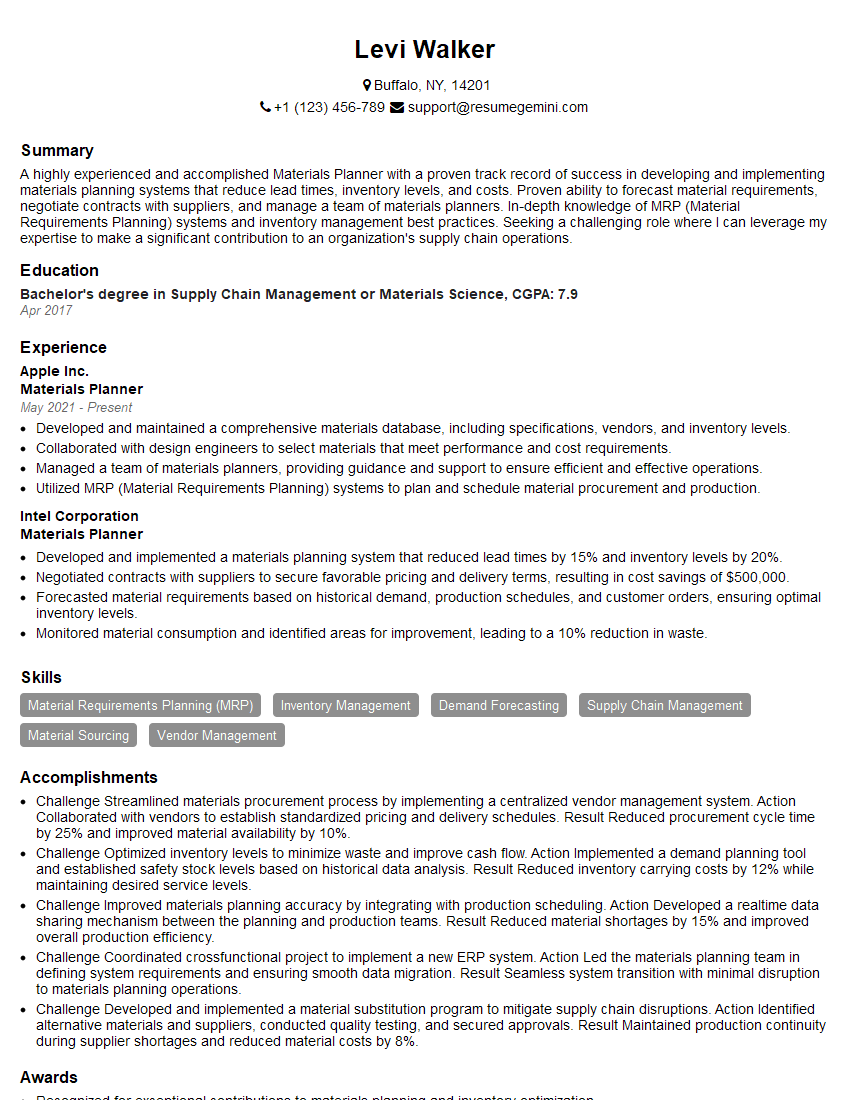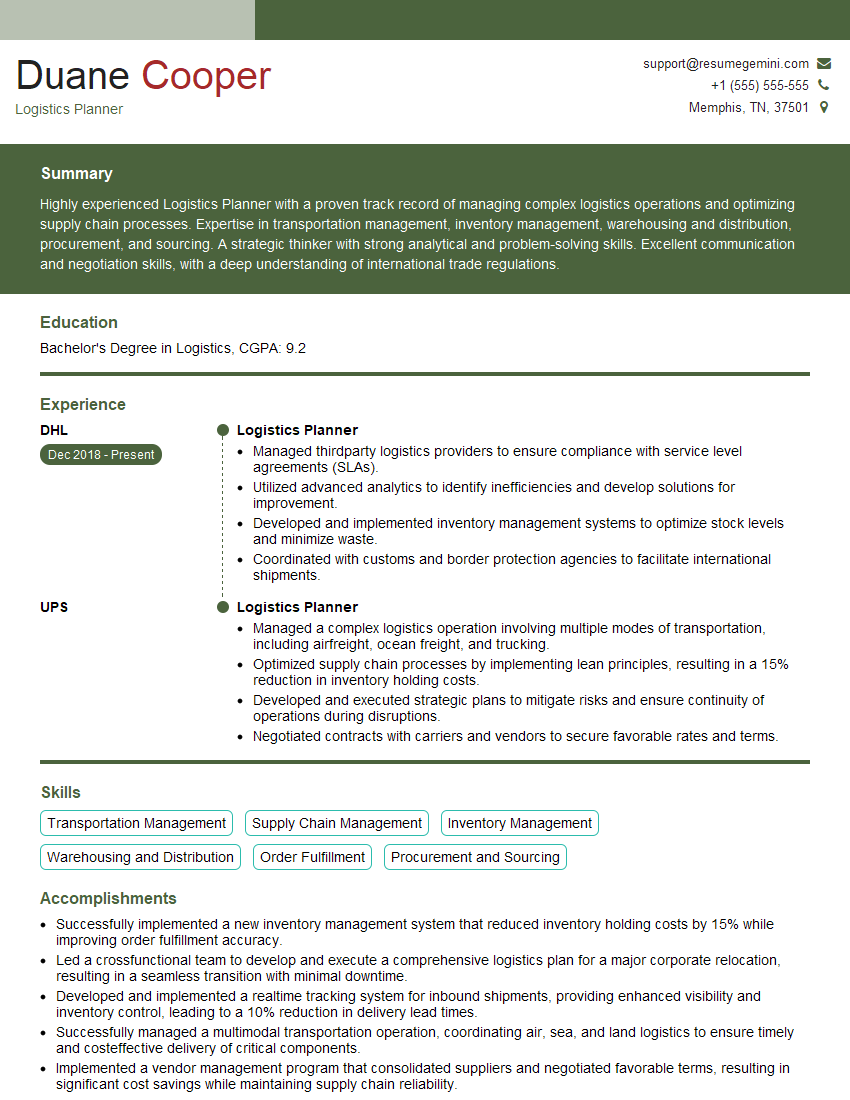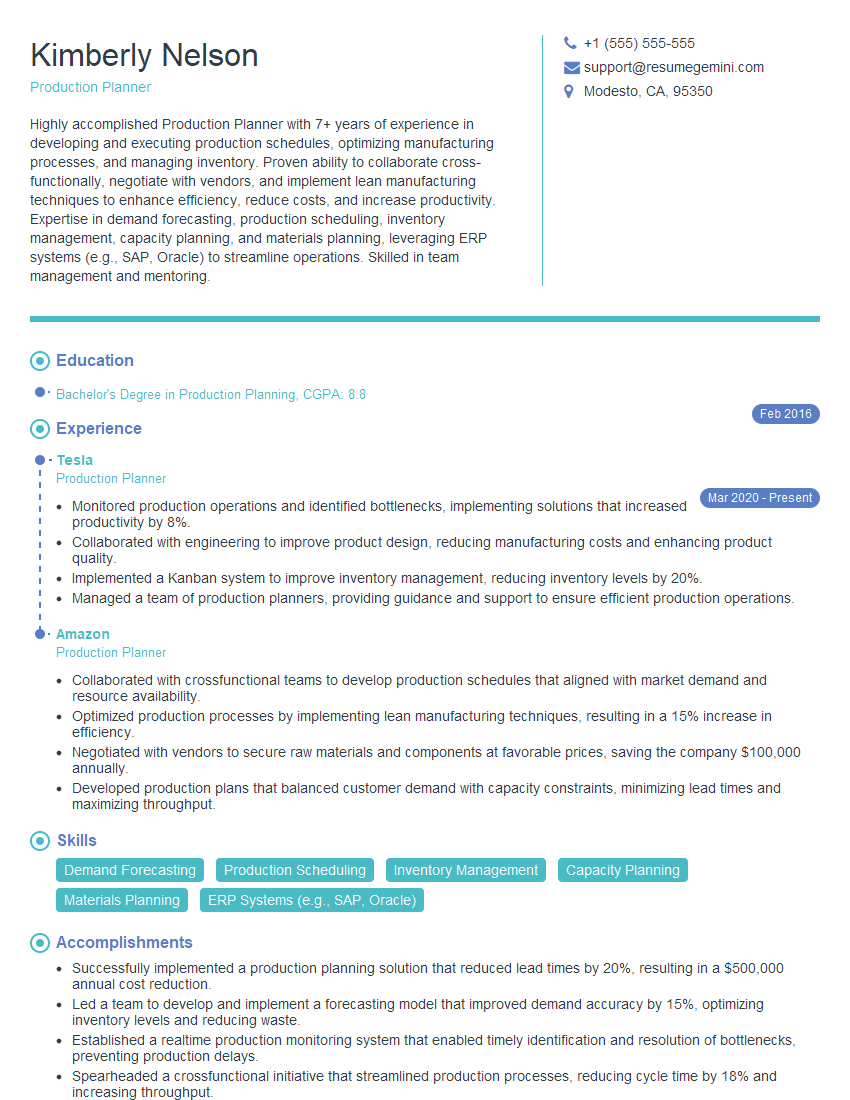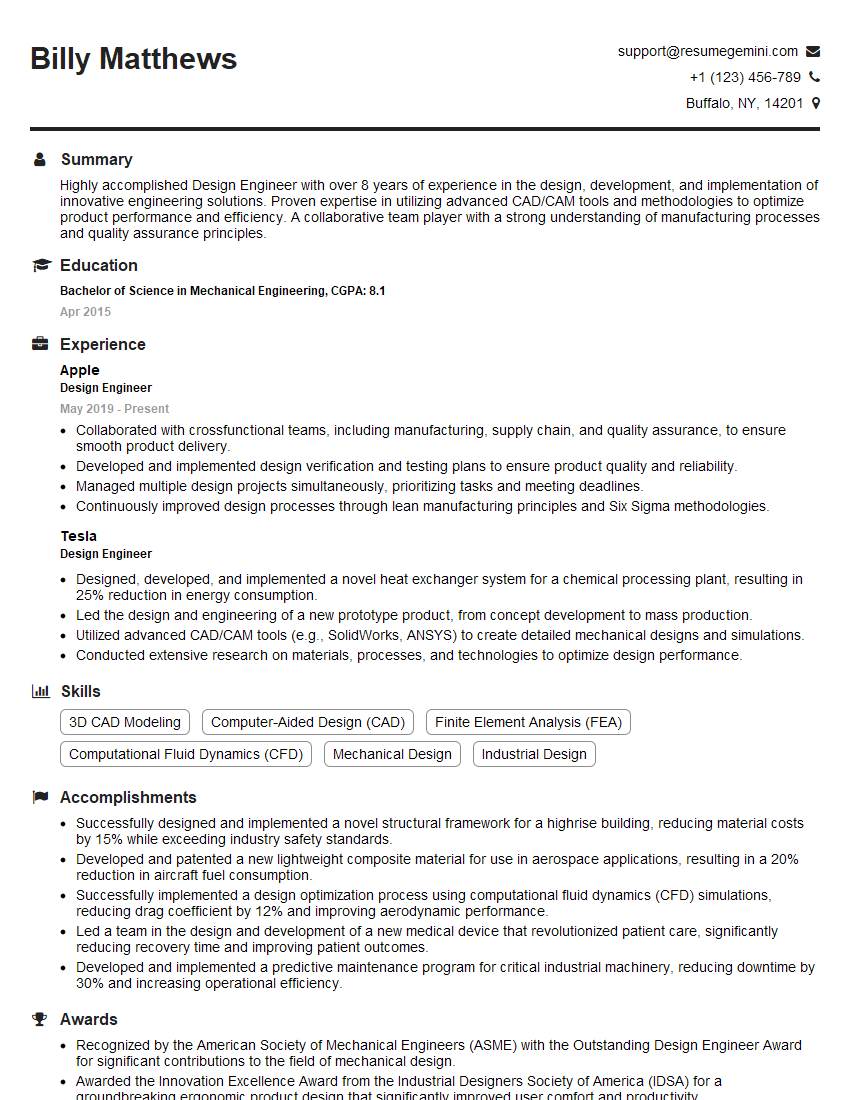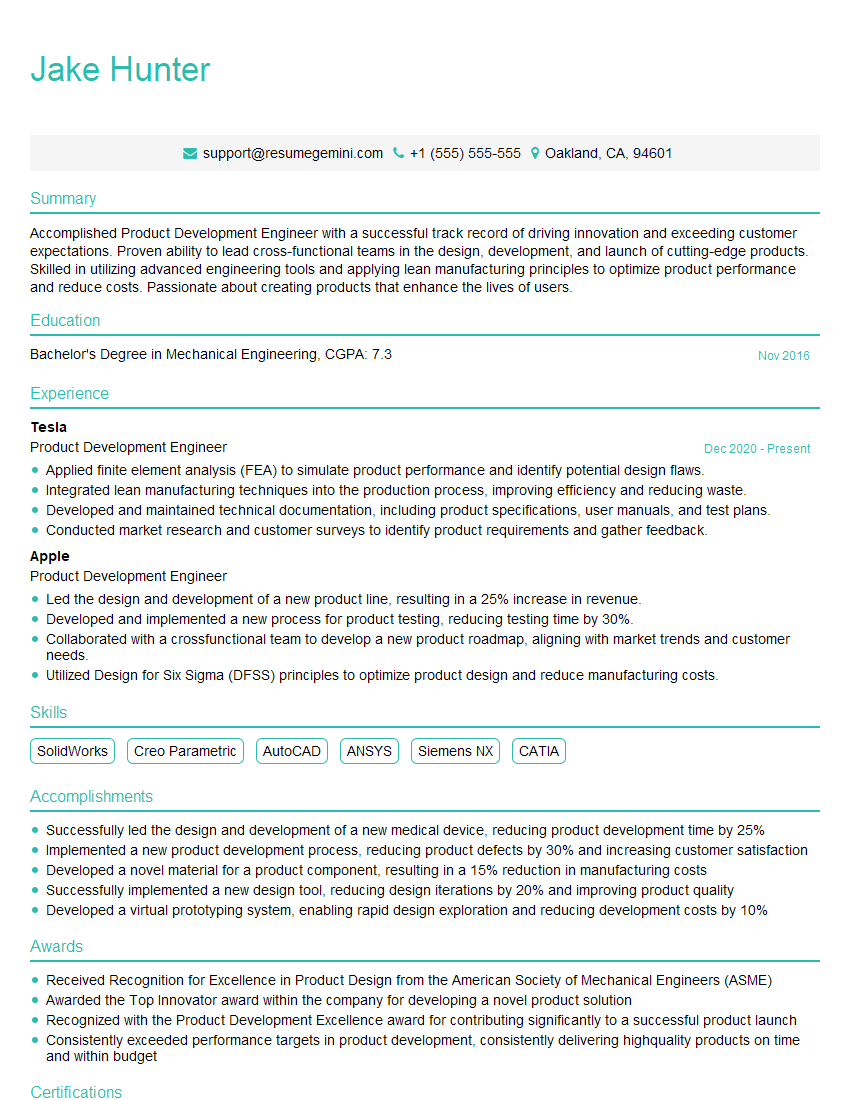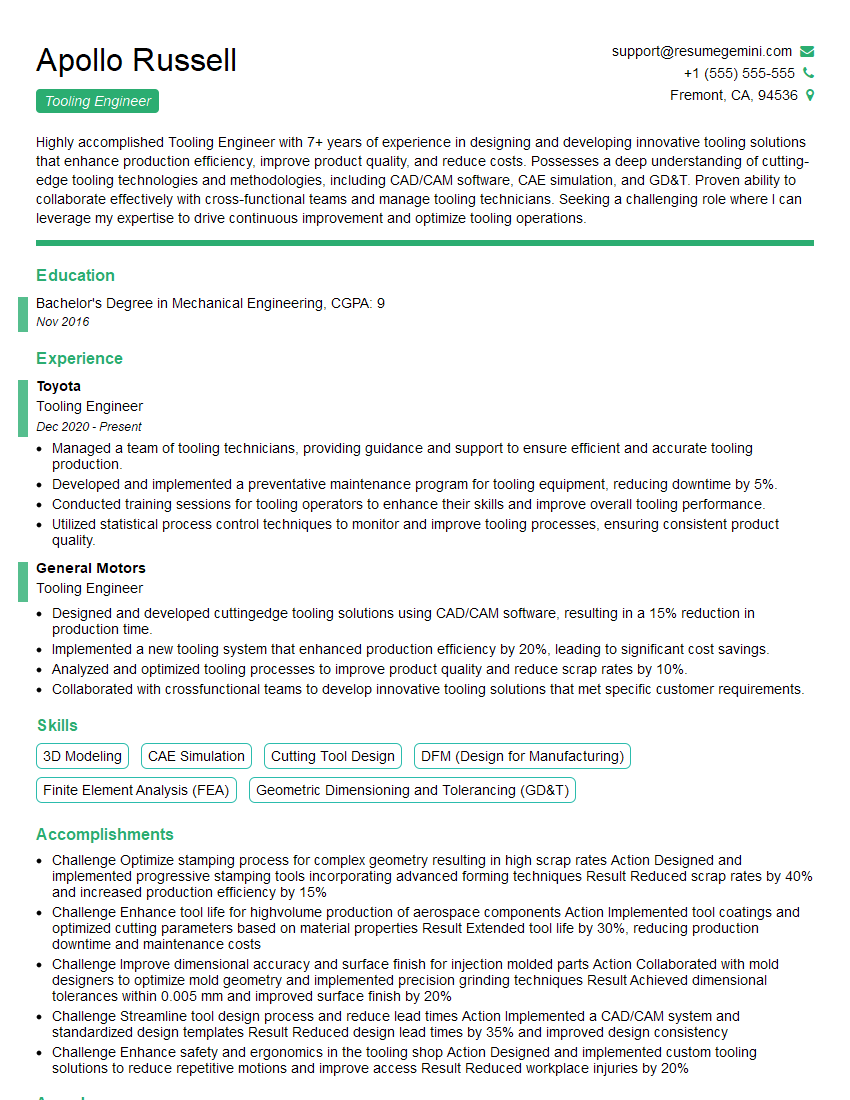Unlock your full potential by mastering the most common Planing and Shaping interview questions. This blog offers a deep dive into the critical topics, ensuring you’re not only prepared to answer but to excel. With these insights, you’ll approach your interview with clarity and confidence.
Questions Asked in Planing and Shaping Interview
Q 1. Explain the difference between MRP and ERP systems.
MRP, or Material Requirements Planning, and ERP, or Enterprise Resource Planning, are both systems designed to manage resources within a business, but they differ significantly in scope and functionality. Think of MRP as a focused spotlight, illuminating only the production planning aspect, while ERP is a comprehensive floodlight, illuminating the entire organization.
MRP primarily focuses on inventory management and production scheduling. It calculates the precise quantities of materials needed, when they’re needed, and schedules their procurement and production to meet final product demand. It’s a crucial tool for manufacturing companies managing complex bill of materials (BOMs).
ERP, on the other hand, is a much broader system integrating various business functions like finance, human resources, supply chain management, and customer relationship management (CRM), in addition to production planning. It provides a single source of truth across the entire organization, improving data visibility and collaboration. An ERP system might use MRP as a module within its broader functionality.
For example, imagine a bicycle manufacturer. An MRP system would help them determine how many bicycle frames, handlebars, and wheels to order based on projected sales of complete bicycles. An ERP system would handle this, plus employee payroll, financial reporting, customer orders, and even marketing campaigns – all within a single, integrated platform.
Q 2. Describe your experience with capacity planning techniques.
My experience with capacity planning techniques is extensive, encompassing both short-term and long-term strategies. I’ve utilized various methods, including theoretical capacity calculation, which involves analyzing the maximum output of a machine or process under ideal conditions. This is vital for understanding the upper limits of production. I also have significant practical experience with effective capacity calculation which considers real-world factors like planned downtime, machine maintenance, and worker breaks, giving a more realistic view of attainable output.
Furthermore, I have considerable experience with techniques like capacity requirement planning (CRP), where I’ve used software tools to analyze capacity needs against production schedules, identifying potential bottlenecks and resource constraints. I’ve successfully implemented solutions involving resource leveling (adjusting schedules to smooth out peaks and valleys in resource demand) and capacity expansion (adding new equipment or personnel).
In one project, I used simulation modeling to assess the impact of different capacity scenarios on lead times and costs. This allowed the company to make a data-driven decision on whether to invest in new machinery or to optimize existing processes. The simulation showed that process optimization was the more cost-effective solution in the short term, providing immediate improvements to capacity without the large capital investment of new machinery.
Q 3. How do you handle unexpected disruptions to the production schedule?
Unexpected disruptions are inevitable in manufacturing. My approach involves a multi-faceted strategy prioritizing swift action and clear communication.
- Immediate Assessment: First, I quickly assess the nature and severity of the disruption – Is it a machine malfunction, a supplier delay, or a sudden surge in demand? This helps prioritize the response.
- Contingency Planning: I rely on well-defined contingency plans. These plans detail alternative solutions for common disruptions, such as using backup machines, sourcing materials from alternative suppliers, or adjusting production priorities.
- Communication: Open communication is key. I inform all relevant stakeholders – production teams, suppliers, and clients – about the disruption and the planned actions. Transparency helps manage expectations and avoids unnecessary panic.
- Problem-Solving: I use problem-solving techniques like root cause analysis (RCA) to understand the underlying cause of the disruption and implement corrective measures to prevent recurrence. This ensures long-term resilience.
- Rescheduling: I use appropriate scheduling algorithms (discussed in more detail in a later question) to reschedule production based on the revised circumstances, prioritizing critical tasks and minimizing delays.
For example, during a supplier delay, I’ve successfully negotiated expedited shipping from an alternative supplier while simultaneously optimizing production to utilize available resources efficiently, limiting the impact on the final delivery date.
Q 4. What methods do you use for forecasting demand?
Forecasting demand is critical for effective planning. I employ a combination of quantitative and qualitative methods, tailoring my approach to the specific product and market conditions.
- Quantitative Methods: These include time series analysis (like moving averages and exponential smoothing), which identify trends and seasonality in historical sales data. Regression analysis helps to identify the relationships between demand and various factors, such as price, advertising, and economic indicators. I also use ARIMA models for more complex time-series data.
- Qualitative Methods: These involve incorporating expert judgment, market research, and customer surveys. Sales force composite, where sales representatives provide their individual forecasts, is a valuable technique. Delphi method can be used to gain consensus from a panel of experts.
A recent project involved forecasting demand for a new product line. Due to the lack of historical data, we relied heavily on market research and expert opinions. We used a combination of the Delphi method and a conjoint analysis to estimate market size and customer preferences, generating a robust forecast to inform production capacity planning.
Q 5. Explain your understanding of lean manufacturing principles.
Lean manufacturing principles aim to eliminate waste and maximize value for the customer by optimizing processes. It’s not just about cost reduction; it’s about delivering high-quality products efficiently and effectively.
My understanding encompasses the core principles:
- Value Stream Mapping: Identifying all steps in the production process to identify and eliminate non-value-added activities (waste).
- Just-in-Time (JIT) Inventory: Minimizing inventory by producing goods only when needed, reducing storage costs and waste.
- Kaizen (Continuous Improvement): Constantly seeking small, incremental improvements to processes.
- 5S Methodology: Organizing the workplace for efficiency and safety (Sort, Set in Order, Shine, Standardize, Sustain).
- Poka-Yoke (Error Proofing): Designing processes to prevent errors from occurring.
In a previous role, we implemented a Kanban system, a visual system for controlling work flow, reducing lead times by 30% and significantly improving inventory management. This illustrates how lean principles, when applied strategically, can lead to significant operational improvements.
Q 6. How do you prioritize tasks in a high-pressure environment?
Prioritizing tasks under pressure requires a structured approach. I use a combination of techniques to ensure the most critical tasks are addressed first.
- Prioritization Matrix (Eisenhower Matrix): This categorizes tasks based on urgency and importance, allowing me to focus on high-impact, urgent tasks first. This helps avoid getting bogged down in less important activities.
- MoSCoW Method: This method categorizes requirements as Must have, Should have, Could have, and Won’t have. This is useful when dealing with multiple projects or tasks with varying degrees of importance.
- Dependency Analysis: I identify task dependencies, understanding which tasks need to be completed before others can start, allowing for efficient sequencing.
- Timeboxing: Allocating specific time blocks for focused work on high-priority tasks. This prevents multitasking and improves concentration.
I also find that regular communication with the team, clearly outlining priorities and adjusting plans as needed, is vital in maintaining focus and achieving objectives under pressure.
Q 7. Describe your experience with different scheduling algorithms.
My experience encompasses various scheduling algorithms, each with its strengths and weaknesses. The choice of algorithm depends heavily on the specific context—the type of production, the constraints, and the objectives.
- First-Come, First-Served (FCFS): A simple algorithm but can lead to inefficient scheduling if tasks have vastly different processing times.
- Shortest Processing Time (SPT): Prioritizes tasks with the shortest processing times, minimizing average completion time but may starve longer tasks.
- Earliest Due Date (EDD): Prioritizes tasks with the earliest due dates, minimizing tardiness but may lead to longer average completion times.
- Critical Ratio (CR): A more sophisticated algorithm that considers both remaining processing time and remaining due date, balancing the need to meet deadlines with minimizing average completion time.
- Priority Dispatching Rules: Allow for the incorporation of multiple factors like due date, priority, and processing time, enabling a more nuanced approach.
I have practical experience implementing and optimizing these algorithms using both manual methods and specialized scheduling software. In one project, we switched from a simple FCFS to a CR algorithm, resulting in a significant reduction in lead times and improved on-time delivery.
Q 8. What software or tools are you proficient in for planning and shaping?
My proficiency in planning and shaping software spans a range of tools, each suited for different aspects of the process. For instance, I’m highly experienced with MRP (Material Requirements Planning) software like SAP APO and Oracle’s Advanced Planning and Scheduling (APS), which are crucial for managing complex bills of materials and forecasting demand. These systems allow for detailed capacity planning and what-if analysis to optimize production schedules. For visualizing production flows and identifying bottlenecks, I utilize simulation software such as AnyLogic or Arena. Finally, I rely on data analytics tools like Tableau and Power BI for data visualization, trend analysis, and performance monitoring, allowing me to identify areas for improvement in our planning and shaping strategies.
Beyond these specialized tools, I’m proficient in standard productivity suites like Microsoft Excel and Project, utilizing their functionalities for detailed scheduling, tracking, and reporting. My expertise extends to using collaborative platforms like Microsoft Teams and Slack for efficient communication and project management within cross-functional teams.
Q 9. How do you ensure the accuracy of your production plans?
Ensuring accuracy in production plans requires a multi-pronged approach. First, I emphasize the importance of accurate demand forecasting, using a combination of historical data, market trends, and sales forecasts. We regularly review and refine our forecasting methods to minimize errors. Second, maintaining an accurate bill of materials (BOM) is crucial. Regular audits and updates to the BOM are essential to account for design changes or material substitutions. Third, capacity planning must be rigorously performed, considering machine availability, workforce capacity, and potential downtime. Finally, regular monitoring and adjustments are key. We continuously compare planned versus actual production, investigating discrepancies and adjusting our plans proactively. This might involve running simulations to test the impact of different scenarios, enabling us to make data-driven decisions.
Q 10. How do you manage inventory levels effectively?
Effective inventory management is a delicate balance between avoiding stockouts and minimizing holding costs. We utilize an ABC analysis to categorize inventory items based on their value and consumption rate. High-value (A) items receive more rigorous monitoring and control, while lower-value (C) items are managed with simpler methods. We employ Just-in-Time (JIT) inventory strategies where appropriate, minimizing storage costs and reducing waste. However, we also maintain safety stock levels for critical components to mitigate the risk of production disruptions due to supply chain uncertainties. The optimal inventory levels are determined through a continuous process of data analysis, considering factors like lead times, demand variability, and potential disruptions. We regularly review our inventory turnover rates and adjust our strategies as needed.
Q 11. Explain your experience with supply chain risk management.
My experience with supply chain risk management involves proactively identifying and mitigating potential disruptions. This includes implementing supplier diversification strategies to reduce dependency on a single source. We also utilize risk assessment tools to identify potential vulnerabilities in our supply chain, such as geopolitical instability, natural disasters, or supplier financial difficulties. We develop contingency plans to address these risks, such as having alternative suppliers or stockpiling critical materials. Regular communication and collaboration with our suppliers are essential for early identification of potential issues. For instance, during a recent global chip shortage, we proactively engaged with our suppliers, securing alternative components and adjusting our production schedules to minimize the impact on our customers. We also continuously monitor market trends and global events to anticipate potential future disruptions.
Q 12. How do you communicate effectively with cross-functional teams?
Effective communication is paramount in a cross-functional environment. I utilize various methods, depending on the audience and the information being conveyed. For example, I use concise email updates for routine progress reports, formal presentations for key stakeholders, and interactive meetings for collaborative problem-solving. I emphasize active listening, ensuring everyone’s perspective is heard and valued. Utilizing project management tools like Asana or Jira helps streamline communication and track progress transparently. Finally, I build strong, trusting relationships with colleagues from different departments, which fosters open communication and collaboration.
Q 13. Describe a time you had to make a difficult decision regarding production scheduling.
In a previous role, we faced an unexpected surge in demand just before a major holiday season. Our existing production schedule couldn’t accommodate the increased volume without significant delays. This decision involved several steps: First, I analyzed the demand forecast, comparing it with our available production capacity. Second, I explored several options, including overtime, subcontracting, and prioritizing specific product lines. Third, I collaborated with sales and marketing to manage customer expectations and potentially adjust pricing. Ultimately, we chose a combination of overtime and subcontracting, prioritizing high-demand products. Though costly, it allowed us to meet the increased demand and minimize negative customer impact. This experience highlighted the importance of flexible planning, close collaboration, and proactive risk assessment.
Q 14. How do you measure the effectiveness of your planning and shaping strategies?
Measuring the effectiveness of planning and shaping strategies involves several key performance indicators (KPIs). We monitor on-time delivery rates to assess the accuracy of our scheduling and production execution. We track inventory turnover rates to evaluate the efficiency of our inventory management practices. We also analyze production lead times to identify areas for improvement in our processes. Finally, we assess customer satisfaction levels, as it directly reflects the success of our overall operations. Regular reviews of these KPIs, coupled with ongoing process improvements, allow for a continuous optimization of our planning and shaping strategies. By comparing our actual performance against our targets and industry benchmarks, we can identify areas of strength and opportunities for improvement.
Q 15. What are some common challenges in planning and shaping, and how do you overcome them?
Common challenges in planning and shaping often revolve around inaccurate forecasting, resource constraints, unforeseen circumstances, and communication breakdowns. Let’s explore each:
- Inaccurate Forecasting: Underestimating demand or overestimating capacity leads to bottlenecks and delays. Overcoming this involves using robust forecasting techniques, incorporating historical data, and regularly reviewing and adjusting plans based on real-time feedback. For example, I once worked on a project where we initially underestimated the time needed for a specific manufacturing step. By implementing a more rigorous data-driven forecasting method, we were able to accurately predict future needs and avoid production delays.
- Resource Constraints: Limited budgets, personnel, or equipment can severely hinder progress. The solution lies in prioritizing tasks, optimizing resource allocation, and exploring alternative resources or technologies. A case in point was a project where we faced budget limitations. We strategically prioritized critical tasks, negotiated better rates with suppliers, and successfully completed the project within budget.
- Unforeseen Circumstances: Unexpected events like equipment malfunctions, supply chain disruptions, or regulatory changes can throw off even the best plans. Mitigation strategies include developing contingency plans, building in buffers, and establishing flexible processes capable of adapting to change. I’ve successfully navigated numerous unexpected supply chain issues by having pre-approved alternative suppliers and proactively communicating potential risks to stakeholders.
- Communication Breakdowns: Poor communication amongst team members, stakeholders, or departments can lead to misunderstandings, errors, and delays. Effective communication is key. This involves establishing clear communication channels, regularly updating stakeholders, and using collaborative tools to ensure everyone is on the same page. Regular project status meetings and transparent reporting were instrumental in overcoming communication issues on a complex project involving multiple teams.
Career Expert Tips:
- Ace those interviews! Prepare effectively by reviewing the Top 50 Most Common Interview Questions on ResumeGemini.
- Navigate your job search with confidence! Explore a wide range of Career Tips on ResumeGemini. Learn about common challenges and recommendations to overcome them.
- Craft the perfect resume! Master the Art of Resume Writing with ResumeGemini’s guide. Showcase your unique qualifications and achievements effectively.
- Don’t miss out on holiday savings! Build your dream resume with ResumeGemini’s ATS optimized templates.
Q 16. Explain your understanding of Six Sigma methodologies.
Six Sigma is a data-driven methodology focused on minimizing defects and improving processes. It aims for near-perfection (3.4 defects per million opportunities). Key aspects include:
- DMAIC (Define, Measure, Analyze, Improve, Control): This is the core framework. Define the problem, Measure its impact, Analyze root causes, Improve processes to address those causes, and Control the improvements to maintain them.
- Statistical Tools: Six Sigma relies heavily on statistical methods like control charts, process capability analysis, and hypothesis testing to identify and quantify variation in processes.
- Process Mapping and Value Stream Mapping: These tools visualize the process flow, identify bottlenecks, and highlight areas for improvement. For instance, value stream mapping helped us pinpoint a significant delay in a manufacturing process, leading to its optimization and increased efficiency.
- Root Cause Analysis: Identifying the underlying causes of problems is crucial. Common techniques include fishbone diagrams (Ishikawa diagrams), 5 Whys, and Fault Tree Analysis.
In planning and shaping, Six Sigma helps ensure projects are well-defined, resources are effectively utilized, and potential problems are identified and addressed proactively.
Q 17. How do you utilize data analytics to improve planning and shaping processes?
Data analytics is invaluable in optimizing planning and shaping. I use data to:
- Forecast Demand: Analyzing historical sales data, market trends, and other relevant factors helps create accurate demand forecasts, allowing for better capacity planning and resource allocation.
- Identify Bottlenecks: Analyzing production data can reveal bottlenecks and areas for improvement. For example, analyzing machine downtime data revealed a specific machine was a recurring bottleneck, prompting a preventative maintenance plan that reduced downtime significantly.
- Monitor Performance: Tracking key performance indicators (KPIs) allows for real-time monitoring of progress, enabling timely interventions if deviations from the plan occur. We use dashboards to visually track KPIs and quickly identify potential issues.
- Optimize Resource Allocation: Data analysis can provide insights into resource utilization, helping to identify areas where resources can be reallocated more effectively.
- Improve Forecasting Accuracy: Machine learning algorithms can be applied to enhance forecasting accuracy by analyzing complex patterns in historical data.
Tools like SQL, Tableau, and Python are commonly employed for data analysis in this context.
Q 18. Describe your experience with root cause analysis.
Root cause analysis is crucial for identifying the underlying reasons behind problems. I’ve extensive experience using various techniques, including:
- 5 Whys: Repeatedly asking “why” to drill down to the root cause. This simple yet effective technique often reveals unexpected underlying issues. For instance, using the 5 Whys on a production line failure helped us discover a faulty component supplier was the true root cause.
- Fishbone Diagrams (Ishikawa Diagrams): These visually represent potential causes categorized by factors like people, machines, materials, methods, environment, and measurement. This allows for a structured brainstorming session identifying multiple potential causes.
- Fault Tree Analysis (FTA): A top-down approach that systematically identifies the causes that can lead to a specific undesirable event (failure). This method is particularly useful for analyzing complex systems.
The choice of technique depends on the complexity of the problem. Regardless of the method, effective root cause analysis requires a systematic approach, data collection, and collaboration with relevant stakeholders.
Q 19. How familiar are you with different types of production processes (e.g., batch, continuous)?
I’m familiar with various production processes:
- Batch Production: Producing goods in batches or lots. This is suitable for products with moderate demand and variability. I’ve managed projects utilizing batch production, focusing on optimizing batch sizes and minimizing setup times.
- Continuous Production: Producing goods continuously without interruption. This is suitable for high-volume, standardized products. My experience includes optimizing continuous processes to maximize throughput and minimize waste.
- Just-in-Time (JIT) Production: Producing goods only when needed to minimize inventory costs. This requires precise planning and coordination. I’ve implemented JIT systems, focusing on improving inventory management and supply chain efficiency.
- Lean Manufacturing: A philosophy aimed at eliminating waste and maximizing value. This involves techniques like Kaizen (continuous improvement) and 5S (sort, set in order, shine, standardize, sustain). I’ve led initiatives implementing Lean principles to enhance efficiency and reduce costs.
Understanding the characteristics of each process is crucial for effective planning and shaping. Choosing the right process for a given product and market demands is essential for success.
Q 20. Explain your experience with project management methodologies (e.g., Agile, Waterfall).
I’m proficient in both Agile and Waterfall project management methodologies.
- Waterfall: A linear sequential approach where each phase must be completed before the next begins. It’s well-suited for projects with clearly defined requirements and minimal expected changes. I’ve successfully managed projects using the Waterfall methodology, ensuring strict adherence to deadlines and deliverables.
- Agile: An iterative approach that emphasizes flexibility, collaboration, and rapid feedback. It’s ideal for projects with evolving requirements and a need for frequent adaptation. I’ve led Agile projects using Scrum and Kanban, fostering a collaborative environment and delivering incremental value rapidly. This involved daily stand-up meetings, sprint reviews, and retrospectives for continuous improvement.
My approach is to select the methodology best suited to the specific project’s characteristics and constraints. Often, a hybrid approach combining elements of both methodologies is most effective.
Q 21. How do you handle conflicting priorities in planning and shaping?
Handling conflicting priorities requires a structured approach. I use these steps:
- Prioritization Matrix: Using tools like a Prioritization Matrix (e.g., MoSCoW method – Must have, Should have, Could have, Won’t have) to rank priorities based on factors like urgency, importance, and impact. This allows for a clear understanding of what needs to be focused on first.
- Stakeholder Alignment: Open communication with stakeholders to understand their needs and priorities. Facilitating discussions to find common ground and negotiate compromises is critical. Clearly communicating trade-offs is essential for buy-in from all parties.
- Resource Allocation: Once priorities are established, allocate resources effectively to support the prioritized tasks. This may involve re-allocating resources from lower-priority tasks to high-priority ones.
- Time Management: Using time management techniques, like timeboxing and task breakdown, to ensure sufficient time is allocated to high-priority tasks. This involves breaking down complex tasks into smaller, manageable units.
- Regular Review and Adjustment: Regularly reviewing priorities and adjusting plans as needed to reflect changing circumstances. Flexibility and adaptability are key in managing conflicting priorities.
This approach allows for a transparent and collaborative process, ensuring that decisions are made strategically and effectively.
Q 22. Describe your experience with material requirements planning (MRP).
Material Requirements Planning (MRP) is a production planning and inventory control system used to manage manufacturing processes. It helps determine the precise quantity and timing of materials needed to meet production schedules. My experience with MRP spans over eight years, working across various manufacturing environments, from small batch production to mass production. I’ve utilized both standalone MRP software and integrated ERP systems that included MRP modules.
In one project, I was tasked with optimizing the MRP system for a company manufacturing customized furniture. We had issues with inaccurate demand forecasting leading to material shortages and excess inventory. To address this, I implemented a more robust forecasting model, incorporating historical sales data, seasonal trends, and market analysis. This resulted in a 15% reduction in inventory holding costs and a significant improvement in on-time delivery. I also collaborated with the procurement team to streamline the ordering process, integrating the MRP system directly with our supplier’s systems for better visibility of material availability.
Another key aspect of my MRP expertise is understanding the Bill of Materials (BOM). Accurate BOMs are crucial for effective MRP planning. I’ve developed and maintained BOMs, ensuring accurate component specifications, quantities, and relationships. This reduces errors and ensures that the right materials are ordered and used in the production process.
Q 23. How do you ensure that your plans align with the overall business objectives?
Aligning planning and shaping activities with overall business objectives is paramount. I approach this through a strategic, top-down approach, starting with a deep understanding of the company’s mission, vision, and key performance indicators (KPIs). I actively participate in strategic planning meetings, ensuring that production plans directly contribute to achieving these objectives.
For instance, if the company’s objective is to increase market share by 20% within the next year, I would develop a production plan that focuses on increasing capacity, expanding product lines, or improving delivery times to meet the anticipated increase in demand. This would involve close collaboration with the sales and marketing teams to accurately forecast demand and ensure that the production plan is aligned with their strategies. Regular progress reviews against established KPIs are vital to ensure alignment remains throughout the planning cycle. Furthermore, using data visualization tools to present plan performance against business objectives makes it easy for stakeholders to understand the progress and identify any potential roadblocks.
Q 24. What is your experience with different types of production scheduling (e.g., Gantt charts, Kanban)?
My experience encompasses various production scheduling techniques. Gantt charts are excellent for visualizing project timelines and dependencies, particularly useful for projects with clearly defined tasks and milestones. I’ve used Gantt charts extensively for managing complex projects with multiple teams and stakeholders, ensuring clear task assignment and progress tracking. For instance, I used a Gantt chart to manage the implementation of a new ERP system in a previous role, outlining project phases, task durations, and resource allocation.
Kanban, on the other hand, is ideal for managing workflows with a focus on continuous flow and limiting work in progress (WIP). This approach is particularly effective in lean manufacturing environments. I implemented a Kanban system for a small manufacturing facility, improving workflow efficiency by reducing bottlenecks and improving lead times. The visual nature of Kanban boards fostered better communication and collaboration among team members. I’ve also used hybrid approaches combining elements of Gantt charts and Kanban, tailoring the scheduling technique to the specific needs of the project or production process.
Q 25. How do you balance the need for efficiency with the need for quality?
Balancing efficiency and quality is a constant challenge in production. My approach centers around a robust quality management system (QMS) integrated into every stage of the planning and shaping process. This means incorporating quality checks at each step, not just at the end. For example, if efficiency dictates running a machine at maximum speed, we must ensure that this doesn’t compromise quality. Regular quality audits, statistical process control (SPC), and employee training are key components of my approach.
Lean methodologies play a critical role in achieving both efficiency and quality. By eliminating waste and streamlining processes, we improve efficiency while also reducing the potential for defects. Implementing 5S methodologies (Sort, Set in Order, Shine, Standardize, Sustain) ensures a clean, organized workspace, which is crucial for preventing errors and improving overall productivity. Ultimately, the goal is not just to produce efficiently, but to produce high-quality products efficiently.
Q 26. Describe your experience with process improvement initiatives.
I’ve been actively involved in several process improvement initiatives throughout my career. One notable project involved streamlining the order fulfillment process for an e-commerce company. By analyzing the current process using value stream mapping, we identified several bottlenecks and areas of inefficiency. We implemented changes such as automating order processing, optimizing warehouse layout, and improving communication between departments. The result was a 25% reduction in order fulfillment time and a significant improvement in customer satisfaction.
In another instance, I spearheaded a Six Sigma project to reduce defects in a manufacturing process. By using DMAIC (Define, Measure, Analyze, Improve, Control) methodology, we identified the root cause of the defects and implemented corrective actions. This led to a significant reduction in defect rate and improved product quality. I strongly believe in data-driven decision making and utilize tools like process mapping, root cause analysis, and statistical analysis to identify opportunities for improvement and measure the effectiveness of implemented changes.
Q 27. How do you stay updated on the latest trends and technologies in planning and shaping?
Staying current with trends and technologies in planning and shaping is vital. I actively participate in industry conferences, webinars, and workshops to learn about new methodologies and technologies. I also subscribe to industry publications and follow thought leaders on social media. This helps me stay informed about advancements in areas such as AI-powered forecasting, predictive maintenance, and digital twin technology.
Furthermore, I actively seek out opportunities to learn and implement new software and tools relevant to planning and shaping. Continuous learning ensures that I can leverage the latest advancements to optimize production processes and improve overall business performance. For instance, recently, I’ve been exploring the use of machine learning algorithms for demand forecasting, and I’m excited about the potential for significant improvements in accuracy and responsiveness.
Key Topics to Learn for Planning and Shaping Interview
- Strategic Planning Frameworks: Understand and apply various frameworks like SWOT analysis, PESTLE analysis, and scenario planning. Be prepared to discuss their practical application in different contexts.
- Resource Allocation & Prioritization: Discuss your experience in allocating resources effectively, prioritizing tasks, and managing competing demands. Showcase your ability to make informed decisions under pressure.
- Project Management Methodologies: Familiarize yourself with Agile, Waterfall, or other relevant methodologies. Be ready to explain your experience with them and how you’ve used them to successfully shape projects.
- Risk Assessment & Mitigation: Demonstrate your understanding of identifying potential risks, assessing their impact, and developing mitigation strategies. Use real-world examples to illustrate your approach.
- Communication & Collaboration: Planning and shaping often involve teamwork. Highlight your skills in effective communication, collaboration, and stakeholder management.
- Data Analysis & Interpretation: Explain how you use data to inform your planning decisions. Show your ability to interpret trends and make data-driven recommendations.
- Change Management: Discuss your experience in managing organizational change, navigating resistance, and driving adoption of new initiatives.
- Problem-Solving & Decision-Making: Showcase your analytical and critical thinking skills. Be ready to describe your approach to problem-solving and decision-making in complex situations.
Next Steps
Mastering planning and shaping skills is crucial for career advancement in virtually any field. These skills demonstrate your ability to lead, strategize, and execute effectively, leading to increased responsibility and higher earning potential. To maximize your job prospects, create a resume that is both impactful and ATS-friendly. ResumeGemini is a trusted resource that can help you build a professional, compelling resume that highlights your planning and shaping expertise. Examples of resumes tailored to planning and shaping roles are available within ResumeGemini to guide your creation. Invest the time to craft a strong resume; it’s your first impression with potential employers.
Explore more articles
Users Rating of Our Blogs
Share Your Experience
We value your feedback! Please rate our content and share your thoughts (optional).
What Readers Say About Our Blog
Hello,
We found issues with your domain’s email setup that may be sending your messages to spam or blocking them completely. InboxShield Mini shows you how to fix it in minutes — no tech skills required.
Scan your domain now for details: https://inboxshield-mini.com/
— Adam @ InboxShield Mini
Reply STOP to unsubscribe
Hi, are you owner of interviewgemini.com? What if I told you I could help you find extra time in your schedule, reconnect with leads you didn’t even realize you missed, and bring in more “I want to work with you” conversations, without increasing your ad spend or hiring a full-time employee?
All with a flexible, budget-friendly service that could easily pay for itself. Sounds good?
Would it be nice to jump on a quick 10-minute call so I can show you exactly how we make this work?
Best,
Hapei
Marketing Director
Hey, I know you’re the owner of interviewgemini.com. I’ll be quick.
Fundraising for your business is tough and time-consuming. We make it easier by guaranteeing two private investor meetings each month, for six months. No demos, no pitch events – just direct introductions to active investors matched to your startup.
If youR17;re raising, this could help you build real momentum. Want me to send more info?
Hi, I represent an SEO company that specialises in getting you AI citations and higher rankings on Google. I’d like to offer you a 100% free SEO audit for your website. Would you be interested?
Hi, I represent an SEO company that specialises in getting you AI citations and higher rankings on Google. I’d like to offer you a 100% free SEO audit for your website. Would you be interested?
good



